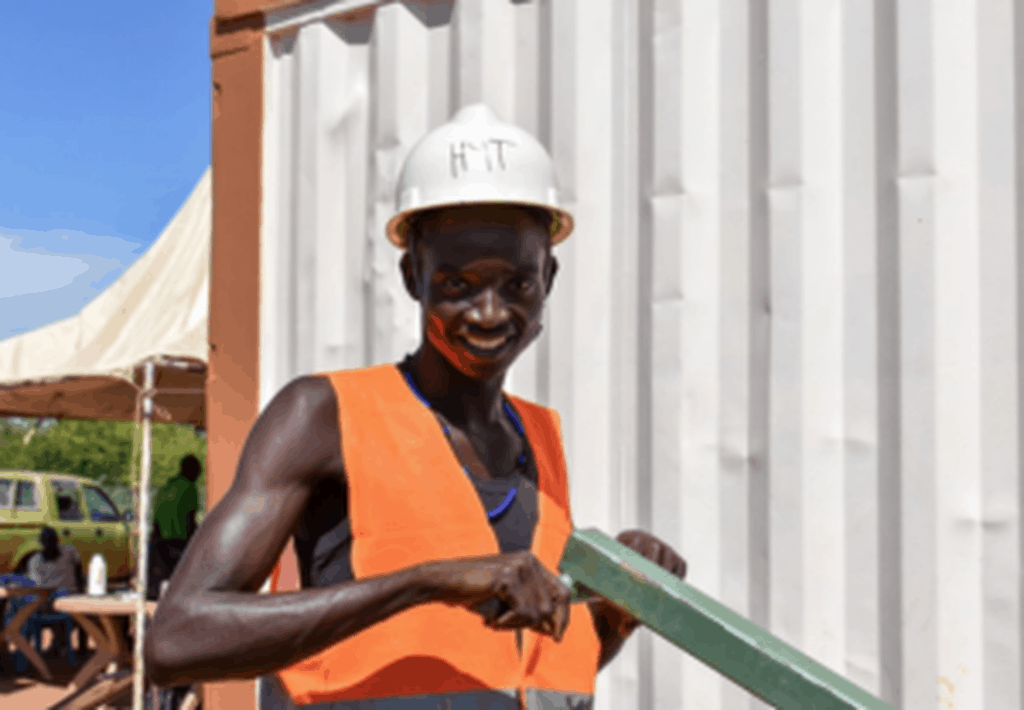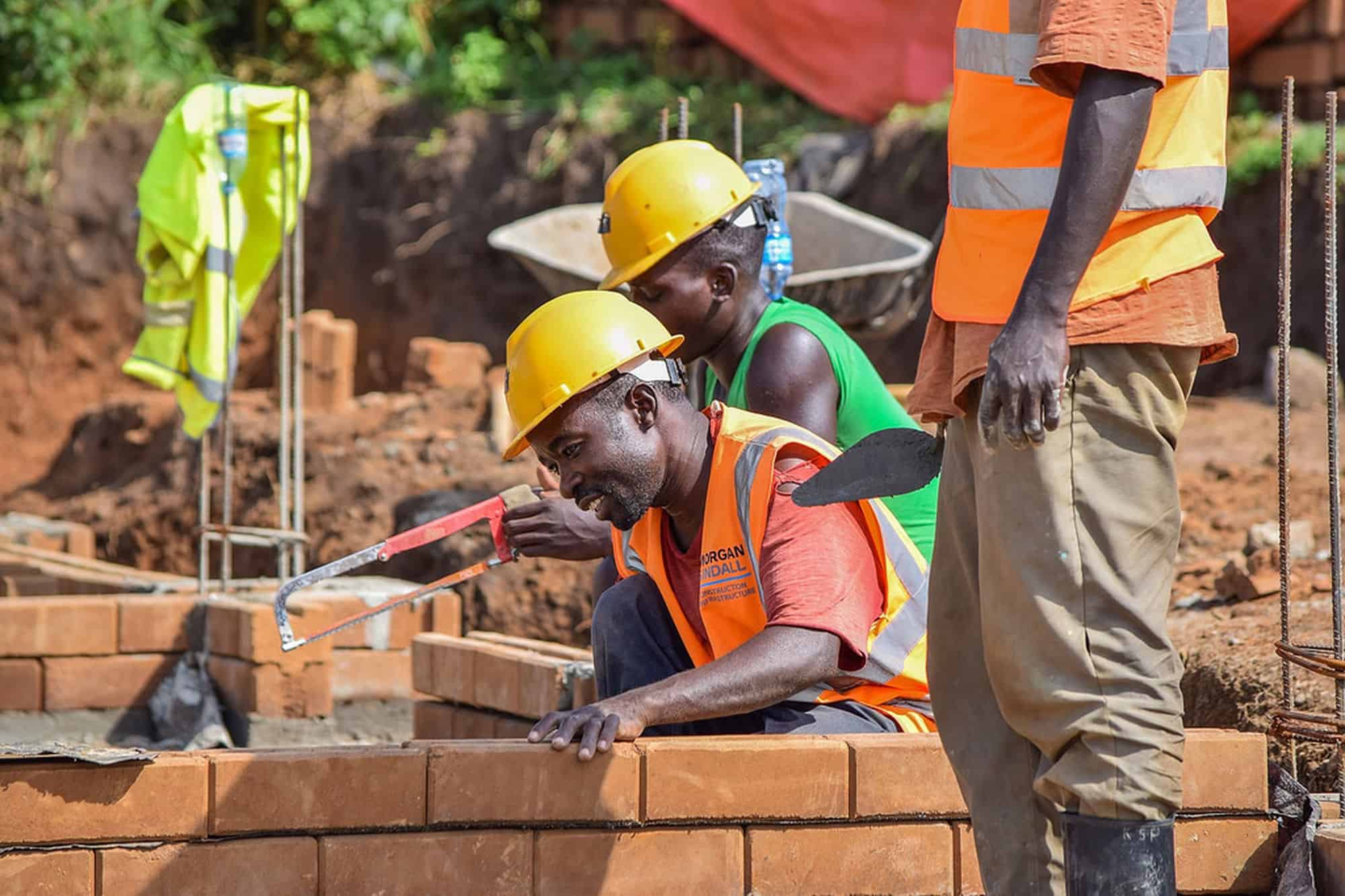This story was first published by Haileybury Youth Trust
Until a few years ago, Bidi Bidi in northern Uganda was an almost empty area of inhospitable land. It is now home to 240,000 refugees from South Sudan, who have fled bitter civil war, at the height of which, up to 6,000 people crossed into Uganda every day. Bidi Bidi is now a sizeable city, administered by the UN refugee agency, UNHCR.
There, the Ashden Award-winning Haileybury Youth Trust has worked with international NGO Mercy Corps to train 26 refugees and Ugandans as builders. The group have so far used their new skills to construct a large meeting space and two kiosks for tradespeople in Bidi Bidi‘s Zone 3 – an area home to 50,000 people.
Uganda’s progressive refugee policy has meant that refugees – there are 1.3 million in the country, mainly from conflicts in South Sudan and the Democratic Republic of Congo – can stay, settle and work. And many do stay. Often for years, preferring the peace and stability of Uganda to the uncertainty of their own countries.
However, Uganda’s refugee settlements have brought enormous challenges. Infrastructure had to be developed rapidly in what had been empty bush just a few years before the refugees arrived. Water had to be located and distributed and sanitation needs met; roads, health centres and schools all had to be built, as well as the many thousands of homes.
This has taken its toll on the fragile Ugandan landscape, with huge numbers of trees cut down for cooking and to fuel the kilns that make the traditional local brick for building. The environmental damage caused by cooking and in making fired bricks is devastating.
Training and technology empowers refugees
The Bidi Bidi project began last May. HYT recruited 26 young people (20 refugee and six Ugandan) who then had four months of intensive construction training, led by HYT’s outstanding training managers, with a special focus on HYT’s innovative, environmentally-friendly building technology, the Interlocking Stabilised Soil Block (ISSB).
The ISSB is a compressed earth block made from mixing soil with a little cement and sand, which is manually compressed, and air cured. The blocks are not fired, saving hundreds of trees and tons of carbon emissions. The results are impressive: the blocks, made on site, are strong and durable and with their interlocking feature, require little or no mortar between courses, making them even more sustainable.
An important aspect of working in refugee areas is to include the Ugandan host community as well as the refugees themselves, so benefits are shared in one of the world’s poorest countries. Another consideration was gender balance. Like in the UK, the construction industry in Uganda is male dominated and so HYT was pleased to have 10 female trainees on this project.
In September, after four months of hard work, the trainees celebrated their graduation. The commitment and skill of both trainees and staff can be seen in the quality of the buildings, which were met with approval and appreciation from UNHCR and the Office of the Prime Minister. Most importantly, the refugee community itself was thrilled to have these new facilities in which to meet and trade.
The environmentally friendly approach to building is now greeted with increased respect. Before the project started, there was some doubt that a compressed earth block, one that wasn’t fired in the local way, would be strong enough. Lab testing proved that HYT’s blocks are both durable and strong, as well as being a sustainable method of building.
Following HYT’s successful project in Zone 3, Mercy Corps invited HYT to construct another meeting centre in Bidi Bidi’s Zone 4. HYT’s first project in one of the world’s largest refugee settlements was an outstanding achievement and paved the way for more life-changing work to come.

Cisco’s story
The project was Cisco’s first proper job since he fled his home in South Sudan in September 2016. Before the programme started Cisco was distributing food to other refugees once a month, earning 10,000 shillings (£2) and sometimes a bar of soap. More usually, however, Cisco says he would sit with his aunt at his new home in the settlement, ‘waiting for food’, while other young refugees would spend their days ‘gambling or chewing miraa’ (khat).
Cisco says he fled Otogo Payam his South Sudanese village when word came of the imminent arrival of government soldiers, who accused men of being rebels, burned houses and killed many of Cisco’s friends. It took Cisco and his aunt five days to get to the Ugandan border. Two days after they had left, the government soldiers arrived in Otogo Payam, ‘chasing people away,’ burning more homes. Cisco had not been able to work in the nearest town as it was too dangerous, with government soldiers imprisoning or killing locals, stealing their possessions and animals. ‘We lost many friends,’ Cisco says. ‘Youths who were like me were killed.’
After being registered as a refugee at the Ugandan border, Cisco and his aunt were taken to Bidi Bidi, the sprawling settlement for 230,000 South Sudanese refugees, where they were given blankets and mats for sleeping, tarpaulins, food rations and a 30 by 30 metre plot, on which to build a home. There is still a regular monthly food distribution, as few refugees have sufficient land – or the means- to grow their own crops. Some of this food aid is sold to buy seeds, cooking oil or clothes from the new roadside market stalls.
Cisco says the last five months has made him ‘somebody different.’ He is now a skilled mason and has already worked on another building site with HYT, again using compressed earth blocks. He hopes to become a project manager himself one day, ‘that is what I am hoping for’, and describes the trainers he learned from as ‘great men.’ He is now able to support his aunt and two nieces.
Will Cisco go back to South Sudan one day? He smiles. “Of course. That is my homeland. Why not go back?”
Finalists:
Norwegian Refugee Council/Practical Action
Jordan is home to more than one million Syrian refugees, most of whom live in poverty. This scheme supports refugees and host communities – by installing solar systems in schools shared by both groups, by bringing solar water heaters to homes rented by refugees, and by offering training to young people from both communities.
United Nations Development Programme
Community-owned solar microgrids have brought higher incomes and reliable energy to conflict-hit Yemen. The grids were created by groups of local entrepreneurs, thanks to grants and support from UNDP Now grid owners – including women – earn a better living, while their neighbours benefit from radically cheaper electricity.

